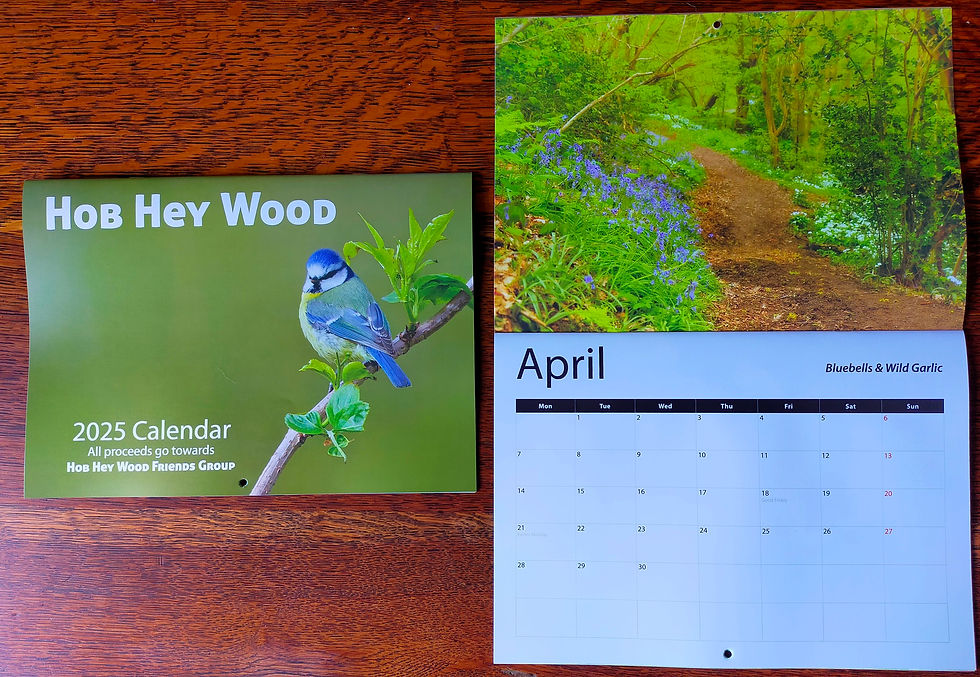Helping a rare butterfly in Hob Hey Wood
- Mark O'Sullivan

- Mar 12, 2021
- 3 min read
Elm were one of the most common trees in Britain, these majestic trees towered to about 100 feet in height, their broad crowns dominating the skyline of many fields, parks, and woodlands across the land.
Then, in the 1960s, a shipment of elm from Canada brought an aggressive form of Dutch elm disease carried on larva of the elm bark beetle. Our elms had no resistance to this disease and the beetles spread the fungus across Britain. Millions of elms died, changing the landscape, seemingly forever. The mature elm, once a common sight, is now extremely rare in Britain.
The fungus wasn’t just a disaster for elms, but also for a butterfly that lives solely on elm trees. The white-letter hairstreak, once common, saw its population crash by 99%. The butterfly is now rare, especially in woodland-poor Cheshire.

White-letter hairstreak on elm in Hob Hey Wood
Last winter, our group found stands of elm in a couple of areas of the wood. We wondered if the white-letter hairstreak might be hanging on in Hob Hey Wood. During the butterflies’ flight period, we set out to find out. White-letter hairstreaks are never easy to see as they fly at the top of the trees, showing as small fluttering shapes against the sky.
On a sunny morning in June three were spotted on an elm! Several more were found on an elm close by; this rare butterfly still lives in Hob Hey!
Video of several white-letter hairstreaks in Hob Hey Wood
Dutch elm disease hasn’t gone away, it still kills elms today. As young trees mature, their barks become rough, allowing the disease-carrying beetle access to the tree. After this, the tree is doomed and will never reach maturity. Sure enough, the elms we found were either young or already dying from Dutch elm disease. Hob Hey Wood Friends Group suddenly had a new conservation goal; protect the white-letter hairstreak and the elms it lives on.
Some of the areas inhabited by elms are becoming overrun with non-native sycamore. These invasive trees were starting to out-compete the elms for space and crowding them out. Our management plan includes a section on non-native tree control and we focused on the elm areas, removing some of the sycamore saplings to give the elms more space and light.
Then, in late 2020, Tom Blundell, a tree warden made us aware of a competition run by the Tree Council to celebrate 30 years of the tree wardening scheme: 30 disease resistant elms were to be awarded to successful applicants. We got busy with our application, if we could win one of these trees, we could help secure the future of the white-letter hairstreak in Hob Hey!
We sent off our application and waited anxiously. In early December we received the welcome news that our application had been successful, one of the disease resistant elms was coming to Hob Hey Wood!
We prepared an area for the elm, close to one of the white-letter hairstreak colonies. We’d planned a tree-planting session with Frodsham’s mayor and representatives of Hob Hey Wood Friends Group, Mersey Forest, and the Wirral Tree Warden Coordinator. Alas, lockdown restrictions prevented that. With spring approaching and trees starting to wake up, we needed to act as soon as we were allowed to. We held on until 8th March when two people could meet outside then Tom and I sprang into action! We ferried the tree down to the wood and planted it in the pre-prepared area.

Tom with 'Tom's elm'
So, what does this mean? Hob Hey Wood now has an elm tree that is 100% resistant to Dutch elm disease. The tree will grow and hopefully become what’s now a rare sight in Britain, a majestic, mature elm tree. It should spread by suckers, in time providing a secure home for the white-letter hairstreak, securing the butterflies future in Frodsham’s ancient semi-natural woodland.
This conservation success story could not have happened without the help of a significant number of people: Caroline Ashton, Clare Olver of Mersey Forest, David Ellwand the Wirral Tree Warden Coordinator, and, of course, Tom Blundell who made us aware of the competition and led the application. Thanks must also go to the Tree Council for providing this magnificent tree. Thank you all!




Comments